This is featured post 1 title
Replace these every slider sentences with your featured post descriptions.Go to Blogger edit html and find these sentences.Now replace these with your own descriptions.

This is featured post 2 title
Replace these every slider sentences with your featured post descriptions.Go to Blogger edit html and find these sentences.Now replace these with your own descriptions.

This is featured post 3 title
Replace these every slider sentences with your featured post descriptions.Go to Blogger edit html and find these sentences.Now replace these with your own descriptions.

Changing Roles for Women
 For most women during the early part of the 20th Century, their role mainly consisted of looking after the family and children in the home. Very few women had other jobs. However with the men gone women were also left with shortages of resources, as well as their fears for the future, and the grief and trauma of losing loved ones.
For most women during the early part of the 20th Century, their role mainly consisted of looking after the family and children in the home. Very few women had other jobs. However with the men gone women were also left with shortages of resources, as well as their fears for the future, and the grief and trauma of losing loved ones.
During World War I, it was uncommon for many women to have jobs, apart from domestic serving roles. The number of women working outside the home did increase slightly during this war but mostly in food, clothing and printing industry jobs that were already established as female roles.
 Many women were also actively involved as nurses and in other active service duties, and contributed more actively to war efforts through military service. Other Australian women were also closely connected with war through male relatives and friends away on military service.
Many women were also actively involved as nurses and in other active service duties, and contributed more actively to war efforts through military service. Other Australian women were also closely connected with war through male relatives and friends away on military service.
However, in World War II women were actively recruited into jobs that had always been the preserve of men.
By 1942, the tides of war had shifted to Australia's doorstep and roles changed out of sheer necessity. Australian women entered the workforce in unprecedented numbers and were even allowed to take on 'men's work'. These were jobs for the war, not for life. Women were paid at lower rates than men and expected to 'step down' and return to home duties after the war.
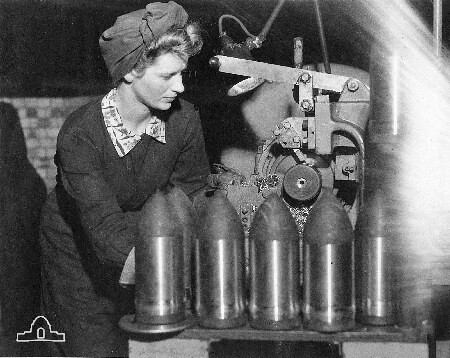 Some of these roles included driving buses, working in factories, shipyards, security guards, mail deliverers, bread carters and The Australian Women's Land Army (AWLA). The AWLA was established in July 1942, in response to labour shortages in country areas. The Women's Land Army recruited women to work on farms where there were no men left to do the hard labour that was traditionally assigned to men. AWLA was not considered a military service and never included benefits such as the pensions, deferred pay and bonuses, which were available to those women who joined Women’s Royal Australian Naval Service (WRANS), Australian Women’s Army Service (AWAS) and others. By 1944 the Australian Women's Land Army had around 3000 members.
Some of these roles included driving buses, working in factories, shipyards, security guards, mail deliverers, bread carters and The Australian Women's Land Army (AWLA). The AWLA was established in July 1942, in response to labour shortages in country areas. The Women's Land Army recruited women to work on farms where there were no men left to do the hard labour that was traditionally assigned to men. AWLA was not considered a military service and never included benefits such as the pensions, deferred pay and bonuses, which were available to those women who joined Women’s Royal Australian Naval Service (WRANS), Australian Women’s Army Service (AWAS) and others. By 1944 the Australian Women's Land Army had around 3000 members.
By the end of the war women were expected to give up their jobs for men who returned home from overseas conflicts, this was often a difficult transition. Many women had enjoyed participating in the workforce, especially the extra income that having a job provided. As a result the 1950s saw a dramatic change in the way women's roles were defined, as females were encouraged back into the home and their traditional roles of wives and mothers reinforced and encouraged.
Exercises:
On a new page in your books put the Heading “Changing Roles for Women”. Under the heading write a 1/2 page summary based upon the information above. After you have completed the summary, download the following resource booklet and read through pages 9 and 10. Answer questions 19, 20, 21, 22, 23, 24 and 25 in your books in full sentences.
Homefront
kokoda
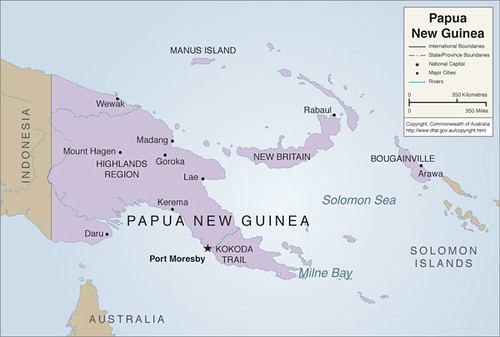
The Kokoda Trail or Track was a path that linked Ower's Corner, approximately 40 km north-east of Port Moresby, and the small village of Wairopi, on the northern side of the Owen Stanley mountain range. From Wairopi, a crossing point on the Kumusi River, the Track was connected to the settlements of Buna, Gona and Sanananda on the north coast.
The name Kokoda, was taken from the village of Kokoda that stood on the southern side of the main range and was the site of the only airfield between Port Moresby and the north coast.
The Japanese had originally planned to capture Port Moresby by a seaborne landing. However this was disrupted by the battle of the Coral Sea, so as a result the Japanese saw the Kokoda Track as a way to capture Port Moresby overland. Troops of the South Seas Detachment began landing at Gona on the 21st July 1942, intending initially just to test the possibility of using the Kokoda Track as a route to invade. Soon the plan was put into action and a full-scale offensive began.
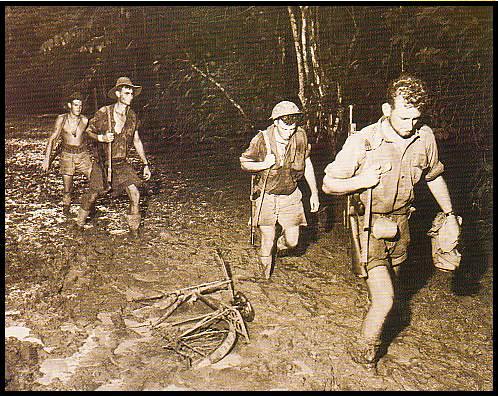 The first fighting occurred between elements of the Papuan Infantry Battalion and the 39th Australian Infantry Battalion at Awala on the 23rd July. Unfortunately the defending forces were unable to hold back the Japanese. They were poorly equipped, did not have effective jungle warfare tactics, and were engaged in fighting at the end of a very long and difficult supply line. A number of desperate delaying actions were fought as the Australians withdrew along the Track. They finally stopped on the 17th September at Imita Ridge, the last natural obstacle along the Track.
The first fighting occurred between elements of the Papuan Infantry Battalion and the 39th Australian Infantry Battalion at Awala on the 23rd July. Unfortunately the defending forces were unable to hold back the Japanese. They were poorly equipped, did not have effective jungle warfare tactics, and were engaged in fighting at the end of a very long and difficult supply line. A number of desperate delaying actions were fought as the Australians withdrew along the Track. They finally stopped on the 17th September at Imita Ridge, the last natural obstacle along the Track.
Although being pushed back was not a desirable outcome, the Australians found themselves in a superior position. Their artillery at Ower's Corner was now in range and their supplies could be trucked most of the way forward. This was in contrast to the Japanese who now had to have their supplies carried all the way from the north coast. As a result of severe losses suffered by the Japanese on the island Guadalcanal, located in the southern Solomon Islands, following the American landing there, the South Seas Detachment was ordered to withdraw to the north coast of Papua and establish a defensive position.
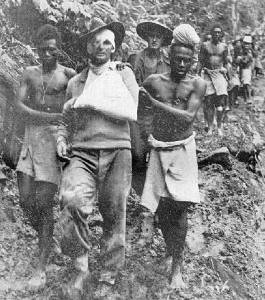 Australian troops of the 25th Brigade then began to edge forward from Imita Ridge on the 23rd September. In the course of their retreat the Japanese fought delaying actions. The conditions that the Australians were forced to purse the Japanese through were hot and humid weather, rain, Tropical Disease, stinking mud and treacherous jungle to name a few. By the 9th December Gona was taken and on the 2nd January 1943 Buna was captured. Sanananda, held by 600 Japanese, was not taken until the 12th January. The Papuan campaign ended with the surrender of Japanese survivors on the 22nd January 1943.
Australian troops of the 25th Brigade then began to edge forward from Imita Ridge on the 23rd September. In the course of their retreat the Japanese fought delaying actions. The conditions that the Australians were forced to purse the Japanese through were hot and humid weather, rain, Tropical Disease, stinking mud and treacherous jungle to name a few. By the 9th December Gona was taken and on the 2nd January 1943 Buna was captured. Sanananda, held by 600 Japanese, was not taken until the 12th January. The Papuan campaign ended with the surrender of Japanese survivors on the 22nd January 1943.
Out of a force of about 20,000 the Japanese had lost 13,000, most of whom had fought to the death rather than surrender. The campaign cost Australia over 6000 casualties.
Exercises:
On a new page in your books put the Heading “Kokoda”. Under the heading write a 1/2 page summary based upon the information above. After you have completed the summary, write the following sub-headings and the questions in your books and answer them in full sentences using the links to the websites listed below.
The Battle for New Guinea
1. Click on Animation, then in the new window click on 'Battle for New Guinea', then 'Battle of the Coral Sea' and read through it.
2. Click on 'Kokoda Track'. What city did Japan sieze and here is it located?
3. Why were the Japanese not able to attack Port Moresby by sea?
4. What was the mountain range that the had to cross?
5. How many troops land on July 21 and what was their intention?
Kokoda Campaign
1. Click on 'Cross-section view of the Kokoda Track'. Describe the conditions the Australians had to endure.
2. Draw a copy of the map into your books.
Fuzzy Wuzzy Angels
1. Who were the Fuzzy Wuzzy Angels?
2. How did they help the Australian forces?
Changing Relationship with America
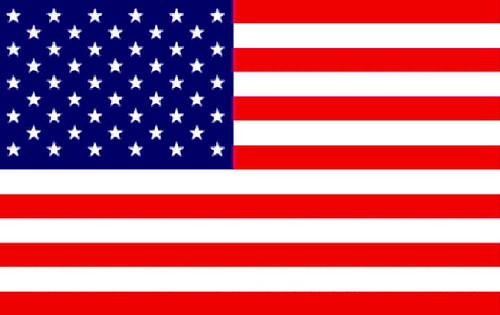 At the beginning of World War II Australia considered itself to be still apart of the British Empire, and as a result always supported Britain’s interests. In 1939 when Britain declared war on Germany, Australia followed Britain’s lead.
At the beginning of World War II Australia considered itself to be still apart of the British Empire, and as a result always supported Britain’s interests. In 1939 when Britain declared war on Germany, Australia followed Britain’s lead.In support of Britain, Australia sent troops from the 6th, 7th and 9th battalion to the Middle East, and 27000 Australians in the air force became involved in the Empire Air Training Scheme that provided air crews to fight in Britain. Australia also sent half of their navy to the Mediterranean to assist in the war effort.
 Australia considered Britain as their ‘Mother Country’ and that in times of crisis Britain would come to Australia’s aid. This belief was supported by the fact that in Singapore stood a British naval force that would act as a front line between Australia and any impending attack from Japan. However on December 10 1941 off the coast of Malaya, two British warships the Prince of Wales and the Repulse, were sunk by Japanese Bombers. This was a major blow to the British presence in the region and Britain’s naval strength at Singapore.
Australia considered Britain as their ‘Mother Country’ and that in times of crisis Britain would come to Australia’s aid. This belief was supported by the fact that in Singapore stood a British naval force that would act as a front line between Australia and any impending attack from Japan. However on December 10 1941 off the coast of Malaya, two British warships the Prince of Wales and the Repulse, were sunk by Japanese Bombers. This was a major blow to the British presence in the region and Britain’s naval strength at Singapore.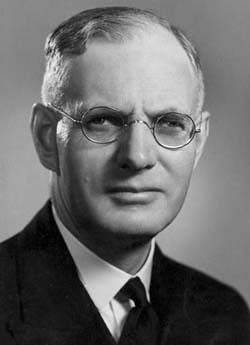 By the end of December 1941, Australia became aware that they were both vulnerable and alone. For Britain could not afford to provide any more support in the South Pacific and Asia regions due to Britain’s increasing problems with Germany in Europe. The Australian government therefore turned to the United States of America for help and in an article in the Melbourne Herald on December 26 1941, Australian Prime Minister John Curtin appealed to America: “Without any inhibitions of any kind I make it quite clear that Australia looks to America, free of any pangs as to our traditional links or kinship with the United Kingdom.”
By the end of December 1941, Australia became aware that they were both vulnerable and alone. For Britain could not afford to provide any more support in the South Pacific and Asia regions due to Britain’s increasing problems with Germany in Europe. The Australian government therefore turned to the United States of America for help and in an article in the Melbourne Herald on December 26 1941, Australian Prime Minister John Curtin appealed to America: “Without any inhibitions of any kind I make it quite clear that Australia looks to America, free of any pangs as to our traditional links or kinship with the United Kingdom.” This appeal caused controversy across the world. For some it meant a disloyal rejection of Britain and for others it meant a bold recognition of Australia's desperate position. Unfortunately for Australia the U.S.A. was not too interested in taking up this role, with the U.S. president famously stating that the appeal “tasted of panic and disloyalty."
This appeal caused controversy across the world. For some it meant a disloyal rejection of Britain and for others it meant a bold recognition of Australia's desperate position. Unfortunately for Australia the U.S.A. was not too interested in taking up this role, with the U.S. president famously stating that the appeal “tasted of panic and disloyalty."By February 1942 the Japanese had defeated British and Australian forces to take control of Singapore. This was the last great protection for Australia. Soon after the fall of Singapore Australia began to endure attacks on the Australian mainland by the Japanese. First with the initial wave of air raids and bombings on the Northern Territory capital city Darwin, then the submarine incursions into Sydney Harbour and finally the sporadic attacks along the eastern coast.
 By March 1942 The American base in the Philippines came under threat by the Japanese. Australia was suddenly seen as a strategic importance to the U.S.A. and as a result of this self interest American President Franklin Roosevelt ordered his Commander in the Pacific, General Douglas MacArthur, to move his headquarters to Australia and take up the role of Supreme Commander of the South West Pacific region.
By March 1942 The American base in the Philippines came under threat by the Japanese. Australia was suddenly seen as a strategic importance to the U.S.A. and as a result of this self interest American President Franklin Roosevelt ordered his Commander in the Pacific, General Douglas MacArthur, to move his headquarters to Australia and take up the role of Supreme Commander of the South West Pacific region.In the years since World War II, Curtin's appeal to America has been seen as the beginning of Australia's alliance with the U.S. and movement away from Britain. This alliance has seen Australia follow the United States of America into many armed conflicts since World War II.
Exercises:
On a new page in your books put the Heading “Change in Relationship with America”. Under the heading write a 1/2 page summary based upon the information above. After you have completed the summary, write the following sub-headings and the questions in your books and answer them in full sentences using the links to the websites listed below.
Battle of the Philippines
1. How many planes did the Japanese use against the Philippines?
2. What time did the Japanese plan to attack and what defences did they expect?
General Douglas MacArthur
1. After the disaster of the Philippines what happened to General MacArthur?
2. What did he expect his troops to do?
Bombing of Darwin and Sydney
 During World War II Darwin, the capital of Australia's Northern Territory, was a major port for the Australian Navy and a major base for the Australian Army. Darwin was used for repairs, re-supply and home for Australian commando units. Being so close to the Asia region, Darwin was considered a strategic location by both Australia and Japan.
During World War II Darwin, the capital of Australia's Northern Territory, was a major port for the Australian Navy and a major base for the Australian Army. Darwin was used for repairs, re-supply and home for Australian commando units. Being so close to the Asia region, Darwin was considered a strategic location by both Australia and Japan.On 19 February 1942 war finally came to Australia for the first time since white settlement.
A fleet of around 200 Japanese aircraft were despatched to attack Darwin from a point off the coast of Timor. Early that morning the aircraft passed over Bathurst Island and Catholic missionaries based there radioed Darwin to warn the Australian mainland. However, the Royal Australian Air Force (RAAF) refused to act on the advice believing the missionaries to be mistaken. As the formation began its run over the city the population went out to watch, thinking the planes were American.
Within minutes large amounts of high explosives began dropping from the sky. Japanese aircraft roared in over the town, attacking the harbour and the airfield.
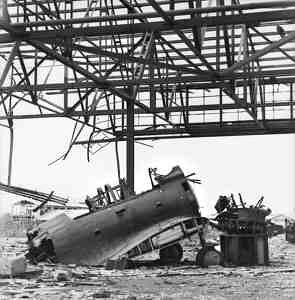 After the first attack, which had done most of its damage in the town and the harbour, a second wave swept in just before midday and concentrated on the airfield.
After the first attack, which had done most of its damage in the town and the harbour, a second wave swept in just before midday and concentrated on the airfield.Virtually unopposed, the attackers left Darwin almost completely decimated. The airfield was a disaster area with a large number of RAAF aircraft destroyed. In the harbour, Australian troopships had been sunk along with a number of cargo vessels. The death toll stood at 243, more than half of which had been on the ships in the harbour with 350 wounded.
Psychologically unprepared for attack, the population understandably panicked. The civilians took to the road in cars, trucks, motor cycles or on foot. There was even panic among servicemen.
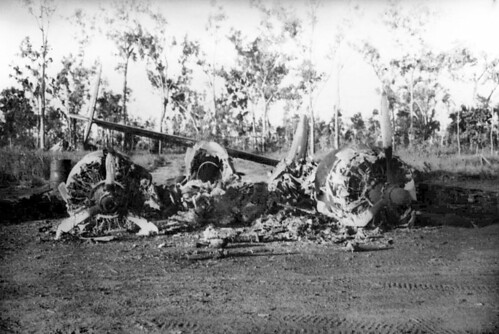 During the bombing numerous servicemen deserted their posts and took to the road with the civilians. In the town, once the fires had been stopped and the dead and injured attended to, a mood of relief was apparent.
During the bombing numerous servicemen deserted their posts and took to the road with the civilians. In the town, once the fires had been stopped and the dead and injured attended to, a mood of relief was apparent.Following the initial attack Darwin was bombed more than 60 times during the course of 1942 and 1943.
Darwin however, was not the only city that would come under attack by the Japanese.
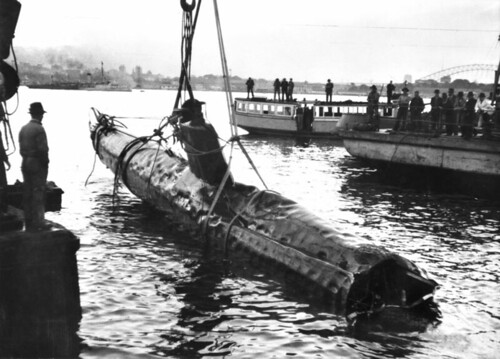 At sunset on Sunday 31 May 1942, there were five Japanese submarines positioned off the New South Wales coast near Sydney. Japanese mother submarines I-22, I-24, and I-27 launched midget submarines about 12kms east of Sydney. These midget submarines infiltrated Sydney Harbour and attempted to torpedo various warships anchored there. The other two submarines, I-21 and I-29, played a supporting role for the midget submarines.
At sunset on Sunday 31 May 1942, there were five Japanese submarines positioned off the New South Wales coast near Sydney. Japanese mother submarines I-22, I-24, and I-27 launched midget submarines about 12kms east of Sydney. These midget submarines infiltrated Sydney Harbour and attempted to torpedo various warships anchored there. The other two submarines, I-21 and I-29, played a supporting role for the midget submarines.Submarine I-21 later shelled Newcastle on 8 June 1942. On the same night Submarine 1-24 also shelled the eastern suburbs of Sydney.
Exercises:
On a new page in your books put the Heading “Australia Stands Alone”. Under the heading write a 1/2 page summary based upon the information above. After you have completed the summary, write the following sub-headings and the questions in your books and answer them in full sentences using the links to the websites listed below.
Air Raids
1. What did the army do in Darwin before the war?
2. When were air raid alerts first sounded?
Using Sources
1. Who is Mr Charles Abbott and what did he do?
2. What similarities does the writer of this article draw between this event and Pearl Harbour?
3. What was Bruce Acland quoted as saying?
Sydney Harbour
1. What was the primary target for the Japanese submarines?
2. What boat was sunk?
3. Take sometime to explore the rest of the site by watching the videos and animation.
Australia Becomes Involved
 In 1939 Germany’s ambition of controlling Europe soon became apparent to France and Britain. After taking over Austria on March 13, 1938 and being handed a large portion of Czechoslovakia at the Munich Conference in September 1938 by Britain and France, Germany took control of the rest of Czechoslovakia in March 1939. Great Britain and France did not want to repeat the bloodshed of World War I and as a result were willing to appease Hitler and avoid another world war by allowing Germany these few concessions. However emboldened by these events, Hitler was confident that he could again move east, this time acquiring Poland without having any other country interfering. As events unfolded, Poland looked toward Britain and France to assist it in the event of a German invasion.
In 1939 Germany’s ambition of controlling Europe soon became apparent to France and Britain. After taking over Austria on March 13, 1938 and being handed a large portion of Czechoslovakia at the Munich Conference in September 1938 by Britain and France, Germany took control of the rest of Czechoslovakia in March 1939. Great Britain and France did not want to repeat the bloodshed of World War I and as a result were willing to appease Hitler and avoid another world war by allowing Germany these few concessions. However emboldened by these events, Hitler was confident that he could again move east, this time acquiring Poland without having any other country interfering. As events unfolded, Poland looked toward Britain and France to assist it in the event of a German invasion.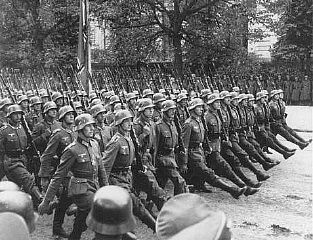 On September 1, 1939, Germany invaded Poland. This event officially marked the beginning of World War II. It was an uneven contest with five German armies consisting of approximately 1.5 million men, 1900 modern aircraft and 2,000 tanks marched upon fewer than a million Polish troops with a small number of armoured vehicles and less than 500 aircraft.
On September 1, 1939, Germany invaded Poland. This event officially marked the beginning of World War II. It was an uneven contest with five German armies consisting of approximately 1.5 million men, 1900 modern aircraft and 2,000 tanks marched upon fewer than a million Polish troops with a small number of armoured vehicles and less than 500 aircraft.The German forces occupied all of the frontier zones within five days and by September 7 their forward units were only 25 miles from Warsaw, the Polish capital. The Polish army was split and encircled with the Polish air forces eliminated. By September 17, the war was virtually over. Ten days later, after a devastating German air assault, Warsaw surrendered.
However, unlike Germany’s earlier incursions into European states, the invasion of Poland provoked a global conflict with Britain and France honouring their pact with Poland and declaring war on Nazi Germany on September 3 when it became clear that negotiating a German withdrawal was not going to achieve its goal.
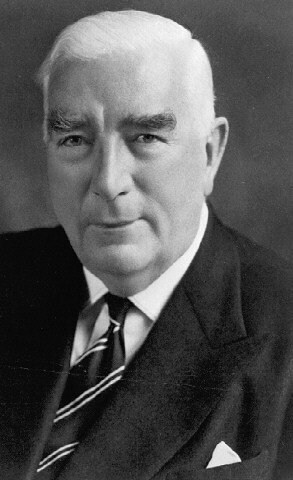 When Britain declared war on Germany, Australia also found that it was again at war. Australian Prime Minister Menzies announced on radio “Fellow Australians. It is my melancholy duty to inform you officially that, in consequence of the persistence of Germany in her invasion of Poland, Great Britain has declared war upon her, and that, as a result, Australia is also at war ... There can be no doubt that where Great Britain stands, there stands the people of the entire British world.”
When Britain declared war on Germany, Australia also found that it was again at war. Australian Prime Minister Menzies announced on radio “Fellow Australians. It is my melancholy duty to inform you officially that, in consequence of the persistence of Germany in her invasion of Poland, Great Britain has declared war upon her, and that, as a result, Australia is also at war ... There can be no doubt that where Great Britain stands, there stands the people of the entire British world.” Initially the Australian Labor Party had resisted and opposed Australia’s involvement in any overseas conflicts. Some Australians felt that the relationship wit Great Britain was not what it once was and that Australia was more of an independent nation. However Prime Minister Menzies was staunchly pro-British and most Australians agreed that Australia should support Britain in this new war effort. Thus it was generally accepted that if Britain was at war, then Australia would be at war.
Initially the Australian Labor Party had resisted and opposed Australia’s involvement in any overseas conflicts. Some Australians felt that the relationship wit Great Britain was not what it once was and that Australia was more of an independent nation. However Prime Minister Menzies was staunchly pro-British and most Australians agreed that Australia should support Britain in this new war effort. Thus it was generally accepted that if Britain was at war, then Australia would be at war.Exercises:
On a new page in your books put the Heading “Australia Becomes Involved”. Under the heading write a 1/2 page summary based upon the information above. After you have completed the summary, write the following sub-headings and the questions in your books and answer them in full sentences using the links to the websites listed below.
Munich 1938
1. What other name was Czechoslovakia known as?
2. Who made up the majority of the population of Czechoslovakia?
3. What did Neville Chamberlain do?
War Declared
1. What did Australia do after war was declared?
2. What did Australia send to help the British?
3. Who did the Australian's fight during the years of 1939 - 1941?
4. Who was the fisrt Australian killed in action?
The Phoney War
1. What was the Maginot Line?
2. What was the Phoney War?






 7:23 PM
7:23 PM
 Mark
Mark

 Posted in:
Posted in: 